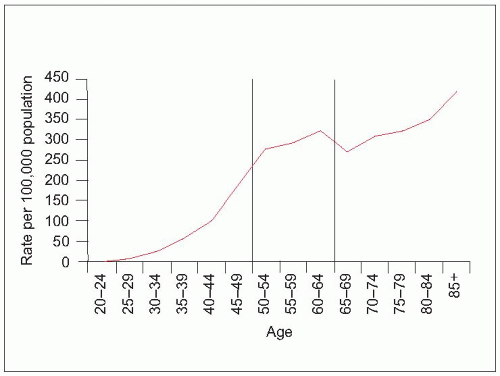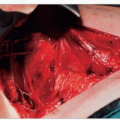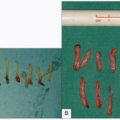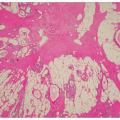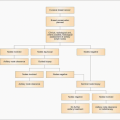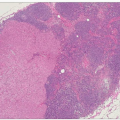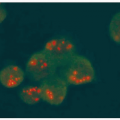Epidemiology of Breast Cancer
Epidemiology (Figures 6.1, 6.2)
|
Breast cancer is the commonest cancer in women, accounting for 15% of all cancers and 30% of cancers in women. In the UK, 40707 breast cancers were diagnosed in 2000, 240 of these (0.6%) were in men. There were 12925 deaths due to breast cancer in the UK in 2002 (accounting for 8% of cancer deaths). Women currently have a 1 in 9 lifetime risk of developing breast cancer. The incidence of breast cancer increased by 10% between 1991 and 2000, although mortality is falling. Factors such as the ageing population, later first pregnancy, smaller family size, and the introduction of screening have made some contribution to the increasing incidence. The change in the organization of breast cancer management, with surgery being performed by breast specialists, more rational, widespread, and effective adjuvant treatment, and breast screening have contributed to the improvement in mortality.
Breast cancer incidence increases with age, oestrogen exposure, higher socioeconomic status, significant radiation exposure, family history, and specific predisposing conditions outlined above. The association with oestrogen exposure is reflected in an increased risk of breast cancer with early menarche, late menopause, reduced parity, postmenopausal obesity, and use of hormone replacement therapy (HRT). There is a weak association with oral contraceptive use and alcohol intake. Many of these factors are not amenable to intervention and are interrelated. An individual considering the use of HRT must weigh up the impact of menopausal symptoms on quality of life against the potential increased risk of breast cancer. HRT use effectively delays menopause and increases breast density, reducing the sensitivity of mammography, and delays the resolution of benign conditions such as breast cysts. There are substantial worldwide geographical variations in the incidence of breast cancer with the highest incidence in western Europe and North America. Oestrogen suppression reduces the incidence of breast cancer, but side-effects (including death) have meant that its use even in high-risk women in the general population is not currently recommended outside specific prevention trials.
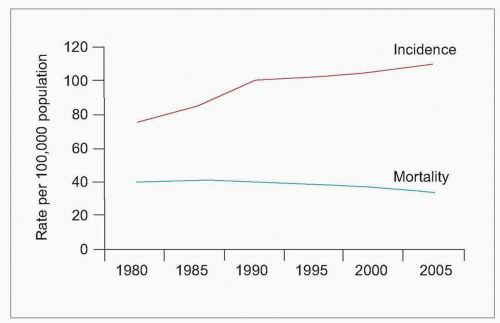 6.1 Changes in breast cancer incidence and mortality in the UK over time. Breast cancer incidence continues to increase while mortality is slowly falling. |
Genetics (Figure 6.3)
The majority of breast cancers occur without any obvious genetic predisposition. Approximately 5% of breast cancers do appear to occur due to an inherited genetic abnormality in an autosomal dominant manner with incomplete penetrance. Two genes which predispose to breast cancer were identified in the mid-1990s – BRCA1 on chromosome 17 and BRCA2 on chromosome 13. Both are large genes with functions related to DNA repair and various mutations result in malignancy. Molecular screening for abnormalities in individuals at risk can be cumbersome and the situation has been complicated by the fact that both genes have been patented.
Stay updated, free articles. Join our Telegram channel

Full access? Get Clinical Tree



